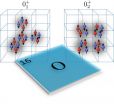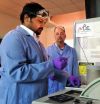(Press-News.org) VIDEO:
Without Twist1 expression, mammary duct tissue fragments maintain a smooth surface (left). When Twist1 is turned on, cells rapidly detach and migrate away from the tissue (right). Both tissue fragments...
Click here for more information.
Studying epithelial cells, the cell type that most commonly turns cancerous, Johns Hopkins researchers have identified a protein that causes cells to release from their neighbors and migrate away from healthy mammary, or breast, tissue in mice. They also found that deletion of a cellular "Velcro protein" does not cause the single-celled migration expected. Their results, they say, help clarify the molecular changes required for cancer cells to metastasize.
Because epithelial cells give rise to 85 percent of all cancers, the work may have implications outside of breast cancer. A summary of the results was published online on March 3 in The Journal of Cell Biology.
Epithelial cells line the inside and outside of organs throughout the body. The team focused their work on mammary epithelial cells, which form the ducts that carry milk within the breast. "Tumor cells have to break their connections to other epithelial cells in order to leave the breast and build metastases in other parts of the body," explains Andrew Ewald, Ph.D., assistant professor of cell biology and oncology at the Johns Hopkins University School of Medicine.
For their study, Ewald's team removed small pieces of mammary tissue from normal mice and grew them in gels that mimic their natural environment. By using colored proteins to mark different types of cells, they were able to use microscopes to watch how cell behavior varied with the genetics of the cells.
The first protein they studied was E-cadherin, which is found on the surface of most epithelial cells and is used to connect epithelial cells to each other. E-cadherin is like the Velcro that holds epithelial cells together, and its absence is often associated with human breast cancers, says Ewald.
In one experiment, the team deleted the protein from normal mouse mammary cells and watched what happened. Expecting the cells to completely disconnect and move out on their own into the surrounding gel, the researchers were surprised to find that most of the epithelial cells remained connected to each other, although their organization was disrupted. Some of the epithelial cells did penetrate the gel, but usually in single-file "columns" that remained connected to the tissue. A similar result was seen in live mice.
"For tumor cells to metastasize, they have to begin interacting with the proteins outside of the tumor and eventually strike out on their own," says Eliah Shamir, a graduate student in Ewald's lab and lead author on the study. "When we deleted E-cadherin, the epithelial cells began interacting more with proteins in the gel, but they didn't lose contact with the rest of the mammary tissue."
In a second set of experiments, the team turned on a gene called Twist1, which is thought to affect the activity of many genes needed to transform groups of stationary epithelial cells into independent, mobile cells. The result, they say, was dramatic. Within 24 hours of turning on Twist1, dozens of individual cells began to move past the epithelial boundary and into the gel beyond. Again, similar results were seen when the experiment was repeated in live mice.
Surprisingly, the researchers say that when they caused epithelial cells lacking E-cadherin to turn on Twist1, the cells were no longer able to escape into the gel as single cells. Instead, they created many "columns" of cells, which didn't detach from the mammary tissue. These results suggest that the single-celled detachment and migration induced by Twist1 actually requires the presence of E-cadherin — the Velcro protein that helps bind the cells together. "This finding is quite counterintuitive," Ewald says, "and we are eager to understand the biology behind it."
Since Twist1 is known to affect the activity of many genes, the researchers have begun to narrow down which of those genes is responsible for the cellular spread they witnessed. With that information, they hope to identify new means of preventing metastasis.
"Our goal is to improve outcomes for patients with metastatic breast cancer, and this work takes us one step closer to doing so," says Ewald.
INFORMATION:
Other authors of the report include Elisa Pappalardo, Khaled Aziz, Phuoc Tran and Joel Bader of the Johns Hopkins University School of Medicine and Danielle Jorgens, Kester Coutinho, Wen-Ting Tsai and Manfred Auer of the Lawrence Berkeley National Laboratory.
This work was supported by grants from the American Cancer Society (RSG-12-141-01-CSM), the National Cancer Institute (P50CA103175), the National Institute of General Medical Sciences (P01 GM051487), the National Center for Research Resources (U54RR020839), the Safeway Foundation for Breast Cancer Research, the Avon Foundation for Women, the Isaac Morris Hay and Lucille Elizabeth Hay Graduate Fellowship Award, the University of California, Berkeley, and the Robert J. Kleberg, Jr. and Helen C. Kleberg Foundation.
On the Web:
Link to article: http://dx.doi.org/10.1083/jcb.201306088
Ewald Lab: http://www.hopkinsmedicine.org/cellbio/dept/EwaldProfile.html
Johns Hopkins Medicine
Media Relations and Public Affairs
Media Contacts: Catherine Kolf; 443-287-2251; ckolf@jhmi.edu
Vanessa McMains; 410-502-9410; vmcmain1@jhmi.edu
Shawna Williams; 410-955-8236; shawna@jhmi.edu END
'Velcro protein' found to play surprising role in cell migration
Research has implications for preventing cancer metastasis
2014-03-13
ELSE PRESS RELEASES FROM THIS DATE:
Novel marker and possible therapeutic target for cardiovascular calcification identified
2014-03-13
Cardiovascular calcification (deposits of minerals in heart valves and blood vessels) is a primary contributor to heart disease, the leading cause of death among both men and women in the United States according the Centers for Disease Control and Prevention (CDC).
"Unfortunately, there currently is no medical treatment for cardiovascular calcification, which can lead to acute cardiovascular events, such as myocardial infarction and stroke, as well as heart failure," says Elena Aikawa, MD, PhD, Director of the Vascular Biology Program at the Center for Interdisciplinary ...
Robotic fish designed to perform escape maneuvers described in Soft Robotics journal
2014-03-13
New Rochelle, NY, March 13, 2014—A soft-bodied, self-contained robotic fish with a flexible spine that allows it to mimic the swimming motion of a real fish also has the built-in agility to perform escape maneuvers. The innovative design and capabilities of this complex, autonomous robot is described in Soft Robotics (SoRo), a new peer-reviewed journal from Mary Ann Liebert, Inc., publishers. The article is available free on the Soft Robotics website at http://www.liebertpub.com/soro.
Andrew Marchese, Cagdas Onal, and Daniela Rus, from MIT (Cambridge, MA) and Worcester ...
Mathematical and biochemical 'design features' for cell decoding of pulses revealed
2014-03-13
Every cell in the body has to sense and respond to chemicals such as hormones and neurotransmitters. They do so by relaying information from receptors to intracellular biochemical pathways that control cell behaviour, but relatively little is known about how cells decode the information in dynamic stimuli.
A team of researchers have found that differences in response kinetics working down the intracellular signalling pathway dictate differential sensitivity to different features of pulsatile hormone inputs.
The study funded by the BBSRC and published today [14 March] ...
Researchers describe oxygen's different shapes
2014-03-13
Oxygen-16, one of the key elements of life on earth, is produced by a series of reactions inside of red giant stars. Now a team of physicists, including one from North Carolina State University, has revealed how the element's nuclear shape changes depending on its state, even though other attributes such as spin and parity don't appear to differ. Their findings may shed light on how oxygen is produced.
Carbon and oxygen are formed when helium burns inside of red giant stars. Carbon-12 forms when three helium-4 nuclei combine in a very specific way (called the triple alpha ...
Creating a graphene-metal sandwich to improve electronics
2014-03-13
RIVERSIDE, Calif. — Researchers have discovered that creating a graphene-copper-graphene "sandwich" strongly enhances the heat conducting properties of copper, a discovery that could further help in the downscaling of electronics.
The work was led by Alexander A. Balandin, a professor of electrical engineering at the Bourns College of Engineering at the University of California, Riverside and Konstantin S. Novoselov, a professor of physics at the University of Manchester in the United Kingdom. Balandin and Novoselov are corresponding authors for the paper just published ...
UT Arlington research says treadmill workstation benefits employees, employers
2014-03-13
Employees who use treadmill workstations not only receive physical benefits but also are more productive at work, according to a recently published study by researchers from The University of Texas at Arlington, the Mayo Clinic and the University of Minnesota.
Darla Hamann, an assistant professor in the UT Arlington School of Urban and Public Affairs, and four colleagues wrote "Treadmill Workstations: The Effects of Walking while Working on Physical Activity and Work Performance", which was published by the journal PLoS One Feb. 20.
In the study, sedentary employees from ...
Heart scans only useful in prescribing statins under certain conditions, UCSF team reports
2014-03-13
As long as inexpensive statins, which lower cholesterol, are readily available and patients don't mind taking them, it doesn't make sense to do a heart scan to measure how much plaque has built up in a patient's coronary arteries before prescribing the pills, according to a new study by researchers at UC San Francisco.
The researchers created a statistical model to predict whether or not it made sense to do the scan, using data from the Multi-Ethnic Study of Atherosclerosis and other sources. They modeled the effects of statin treatment in 10,000 55-year-old women with ...
Researchers destroy cancer with cryoablation & nanoparticle-encapsulated anticancer drug
2014-03-13
Combining nanodrug-based chemotherapy and cryoablation provides an effective strategy to eliminate cancer stem-like cells (CSCs) the root of cancer resistance and metastasis, which will help to improve the safety and efficacy of treating malignancies that are refractory to conventional therapies.
Cryoablation (also called cryosurgery or cryotherapy) is an energy-based, minimally invasive surgical technique that has been investigated to treat a variety of diseases including cancer, which is done by freezing the diseased tissue to subzero temperature to induce irreversible ...
Same-day double knee replacement safe for select rheumatoid arthritis patients
2014-03-13
Same-day bilateral knee replacement surgery is safe for select patients with rheumatoid arthritis, researchers from Hospital for Special Surgery in New York have found.
Generally, patients with an inflammatory systemic disease such as rheumatoid arthritis (RA) are sicker than patients with the degenerative condition osteoarthritis (OA), says senior study author Mark Figgie, M.D., chief of the Surgical Arthritis Service at Hospital for Special Surgery, and the hospital's first Allan E. Inglis, MD, Chair in Surgical Arthritis.
RA patients are more likely to have conditions ...
Heat-based technique offers new way to measure microscopic particles
2014-03-13
Researchers have developed a new heat-based technique for counting and measuring the size of microscopic particles. The technique is less expensive than light-based techniques and can be used on a wider array of materials than electricity-based techniques. The research was performed by faculty at North Carolina State University, the University of North Carolina at Chapel Hill and Marquette University.
"We launched this study purely out of curiosity, but it's developed into a technique that has significant advantages over existing methods for counting and measuring the ...
LAST 30 PRESS RELEASES:
Eye for trouble: Automated counting for chromosome issues under the microscope
The vast majority of US rivers lack any protections from human activities, new research finds
Ultrasound-responsive in situ antigen "nanocatchers" open a new paradigm for personalized tumor immunotherapy
Environmental “superbugs” in our rivers and soils: new one health review warns of growing antimicrobial resistance crisis
Triple threat in greenhouse farming: how heavy metals, microplastics, and antibiotic resistance genes unite to challenge sustainable food production
Earthworms turn manure into a powerful tool against antibiotic resistance
AI turns water into an early warning network for hidden biological pollutants
Hidden hotspots on “green” plastics: biodegradable and conventional plastics shape very different antibiotic resistance risks in river microbiomes
Engineered biochar enzyme system clears toxic phenolic acids and restores pepper seed germination in continuous cropping soils
Retail therapy fail? Online shopping linked to stress, says study
How well-meaning allies can increase stress for marginalized people
Commercially viable biomanufacturing: designer yeast turns sugar into lucrative chemical 3-HP
Control valve discovered in gut’s plumbing system
George Mason University leads phase 2 clinical trial for pill to help maintain weight loss after GLP-1s
Hop to it: research from Shedd Aquarium tracks conch movement to set new conservation guidance
Weight loss drugs and bariatric surgery improve the body’s fat ‘balance:’ study
The Age of Fishes began with mass death
TB harnesses part of immune defense system to cause infection
Important new source of oxidation in the atmosphere found
A tug-of-war explains a decades-old question about how bacteria swim
Strengthened immune defense against cancer
Engineering the development of the pancreas
The Journal of Nuclear Medicine ahead-of-print tip sheet: Jan. 9, 2026
Mount Sinai researchers help create largest immune cell atlas of bone marrow in multiple myeloma patients
Why it is so hard to get started on an unpleasant task: Scientists identify a “motivation brake”
Body composition changes after bariatric surgery or treatment with GLP-1 receptor agonists
Targeted regulation of abortion providers laws and pregnancies conceived through fertility treatment
Press registration is now open for the 2026 ACMG Annual Clinical Genetics Meeting
Understanding sex-based differences and the role of bone morphogenetic protein signaling in Alzheimer’s disease
Breakthrough in thin-film electrolytes pushes solid oxide fuel cells forward
[Press-News.org] 'Velcro protein' found to play surprising role in cell migrationResearch has implications for preventing cancer metastasis







